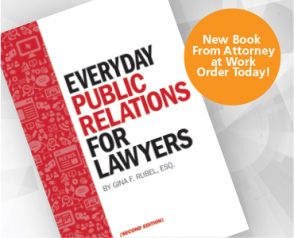Staying abreast of best practices for search engine optimization is a challenge. Indeed, getting website content to appear on the first page of results when people search for “top [insert industry/practice area] lawyer in [insert location]” is a full-time job for many.
So what about us mere mortals who want to maximize the number of visitors to our website?
SEO Writing Tips: Seven Action Areas
Google offers a great starter SEO guide. And here’s an action list we use at my firm to improve SEO and encourage strong writing across the organization, no matter what the message is.
1. Keywords
Are you hoping to be found in search results for specific keywords or a string of keywords? Follow these pointers:
- Use the keywords or phrases in the first sentence or first paragraph. And use them a few more times throughout the remainder of your content.
- Beware of density. The “keyword density” that has been generally accepted as effective is between 2% and 3% — meaning these important keywords should make up around 2% to 3% of the page’s total word count (i.e., the keyword should appear six to nine times per 300 words). However, there is no hard-and-fast rule defined by Google or other search engines for this tactic.
- Limit the legal jargon. Most of your target audience may be unfamiliar with legal terminology, especially if you are targeting business professionals, not other lawyers. Complex legal terms will confuse readers more than inform them.
2. Writing length
Some things to know about length:
- Watch your word count. Generally, your writing should be at least 300-plus words, though some sources say that 2,000 words can be highly effective. The bottom line: Search engines prefer content that tells the whole story.
- Break up your attorney bio. Don’t fill your bio narrative with fluff simply to reach an arbitrary word count. Instead, include information in additional sections or tabs within your bio, such as accolades, professional and community activities, interesting personal details (such as a “You May Not Know” section), experience listings and descriptions.
- Meta matters. Be sure to share key pieces of information about your law practice in the first 160 characters of your bio or blog writing (usually the first sentence or two). Only the first 160 characters are displayed in the search engine results (also called the meta description), and the rest gets truncated.
3. Structure
If the format allows, break paragraphs into a meaningful, clear and digestible size. Your readers will appreciate it. Leaving white space between paragraphs also makes reading and scrolling on a mobile device much easier.
Include headings and subheadings. It helps readers who skim and also encourages more patient readers to continue reviewing your article.
4. Support materials
The more often you write content or are featured in content, the more likely you are to be found in searches. Write blog posts and client alerts, and provide quotes for articles so that your firm’s marketing team can publish and republish the content and add it to your bio. Include internal and external links — links build SEO value.
5. Regular updates
It doesn’t hurt to regularly review and provide updates to your firm bio, or occasionally update an old blog post or article when that topic is relevant again. Refresh your main narrative, experience listings, accolades, professional and community activities and so on. Google will have the chance to re-index bio pages once search engines realize a page has been edited, showing that your bio is now “fresh” content to crawl again.
When updating experience listings, include information such as your most common areas of practice and important recent cases. Mention identifiable terms such as “construction law” within your listings. By adding key terms that your clients may use when searching for counsel, you increase the likelihood of your bio appearing in search results.
6. Time
SEO does not happen overnight. It can take six months to a year before you start seeing a real impact from an “SEO overhaul” of a website. This same concept of building value over time applies to individual pages such as your bio, blog posts and recently authored articles, too.
7. PR and social media
Use your LinkedIn profile to build a larger digital presence. You can link back to your firm bio in your LinkedIn profile, and enhance it by adding more details about your professional career and work history. LinkedIn is the perfect professional network to share your personal accomplishments and show your personality, which can differentiate you from other lawyers. Include publication links, charitable organizations you’re involved with, speaking engagements, awards and recognitions, and more. Don’t be afraid to put yourself out there! (Read “Create a Digital Trail to Your Website Bio” by Jay Harrington.)
Related: “Everyday Public Relations for Lawyers,” 2nd Edition, by Gina Rubel
Influencing Factors Beyond Your Control
While following these tips will help improve your rankings over time, keep in mind that Google and other search engines take into account environmental influences as well. For example, search results can be affected by:
- Location. Based on your computer’s IP address location, you will get different results. For instance, searching keywords in Boston will return different results than if you search for those same keywords while in Key West.
- Search history. Based on your previous search history (if you are logged into a Google or other search engine account), Google will start to tailor results specific to you. This means that over time, your previous searches may influence the results that are delivered to you.
- Popularity. Based on its given traffic, a website will begin to earn “weight” by popularity. The more popular a site is, the more likely its pages will rank highly in search results.
Over time, these SEO tweaks will come more naturally to you. In the meantime, keep this cheat sheet next to your firm’s style sheet as a handy reminder.
 Take a deeper dive with these articles:
Take a deeper dive with these articles:
“Eight Questions a Legal Marketer Needs to Ask About SEO Strategy” by Walter McCorkle
“Say No to These Outdated SEO Tactics” by Mike Ramsey
“Five Tips on Hiring an SEO Firm for Your Law Practice” by Josh Gerben
And for a counter-take:
“Lawyers Need to Look Beyond SEO for True Engagement” by Susan Kostal
















